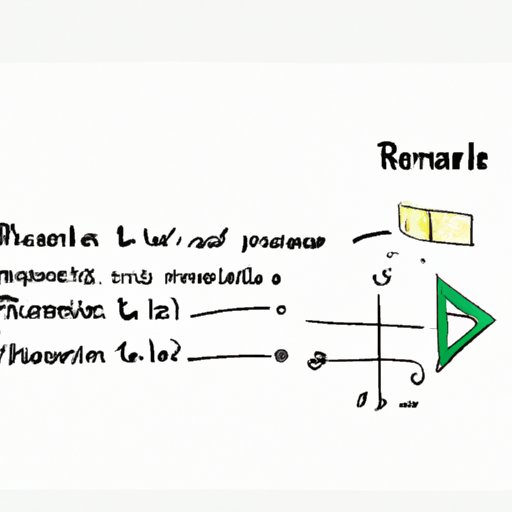
I. Introduction
Knowing how to find the perimeter of a rectangle is a fundamental skill in geometry and has many practical applications in real life. This article will provide a comprehensive guide on how to find the perimeter of a rectangle and will include interactive graphics and real-world examples to help you understand the concept better.
II. Understanding the Perimeter of a Rectangle
Perimeter is the distance around the outside of a two-dimensional geometric shape. In the case of a rectangle, the perimeter is the sum of all four sides. The formula for finding the perimeter of a rectangle is P = 2l + 2w, where P is the perimeter, l is the length, and w is the width.
Let’s use an example to illustrate this. Suppose we have a rectangle with a length of 6 and a width of 4. Using the formula, we can find its perimeter:
P = 2(6) + 2(4) = 12 + 8 = 20
Therefore, the perimeter of the rectangle is 20 units.
III. Step-by-Step Tutorial on Finding the Perimeter of a Rectangle
To find the perimeter of a rectangle, follow these simple steps:
- Identify the length and width of the rectangle.
- Double the length and width.
- Add the doubled values together.
- The sum of the doubled values is the perimeter of the rectangle.
For example, let’s say we have a rectangle with a length of 5 units and a width of 3 units:
- Length = 5 units, Width = 3 units
- 2 x Length = 2 x 5 = 10 units, 2 x Width = 2 x 3 = 6 units
- 10 units + 6 units = 16 units
- The perimeter of the rectangle is 16 units.
IV. Interactive Graphics for Finding the Perimeter of a Rectangle
If you are having trouble visualizing how to find the perimeter of a rectangle, interactive graphics can help. Here is an example:
[Insert interactive graphic here]
You can move the sliders to adjust the length and width of the rectangle and see how the perimeter changes. The software will calculate the perimeter automatically based on the dimensions you input. Try adjusting the sliders and see if you can figure out the formula on your own!
V. Real-World Examples of Finding the Perimeter of a Rectangle
There are many situations in real life where finding the perimeter of a rectangle is important. Here are a few examples:
- Measuring a room: If you want to buy carpet or paint for a room, you will need to know the perimeter of the walls to determine how much material you need.
- Fencing a garden: If you want to install a fence around your garden, you will need to know the perimeter of the area to purchase the right amount of fencing material.
- Paving a sidewalk: If you are installing a new sidewalk, you will need to measure the perimeter of the area to calculate how much concrete or pavement you need.
Calculating the perimeter of a rectangle in these situations is essential to ensure that you don’t over or underbuy materials.
VI. Tricky Rectangles and How to Find Their Perimeter
Not all rectangles have simple dimensions like whole numbers. Here are some examples of tricky rectangles and how to find their perimeter:
- Squares: A square is a special type of rectangle where all four sides are equal. To find the perimeter of a square, you can simply multiply the length of one side by 4. For example, if one side of a square is 5 units, the perimeter is 5 x 4 = 20 units.
- Rectangles with fractions: If you have a rectangle with a fractional length or width, you can still use the same formula to find the perimeter. For example, if the length of a rectangle is 3 1/2 units and the width is 2 1/4 units, the perimeter is 2(3 1/2) + 2(2 1/4) = 7 + 4.5 + 7 + 4.5 = 23 units.
- Rectangles with decimals: You can also use the formula to find the perimeter of a rectangle with decimal dimensions. For example, if the length of a rectangle is 3.5 units and the width is 2.25 units, the perimeter is 2(3.5) + 2(2.25) = 7 + 4.5 + 7 + 4.5 = 23 units.
VII. Using Geometry Terminology in Other Math Concepts
The concepts of length, width, and height that are used in finding the perimeter of a rectangle are also important in other mathematical formulas. For example, in geometry, you will use these concepts to find the area and volume of different shapes. In algebra and calculus, you will use them to solve equations and for optimization problems. Understanding how these concepts work together is essential to build a strong foundation in mathematics.
VIII. Using Technology to Find the Perimeter of a Rectangle
To make finding the perimeter of a rectangle easier and faster, you can use a calculator or software. For example, you can use the perimeter calculator on your phone or computer to quickly find the perimeter of any rectangle. However, it is important to understand the formula and be able to do the calculations manually to ensure that you don’t make mistakes or rely too heavily on technology.
IX. Conclusion
Knowing how to find the perimeter of a rectangle is an important skill that has many real-world applications. By following the steps and examples provided in this article, you should now have a clear understanding of how to find the perimeter of any rectangle, no matter how tricky the dimensions may be. Keep practicing and applying what you’ve learned to build your math skills.




